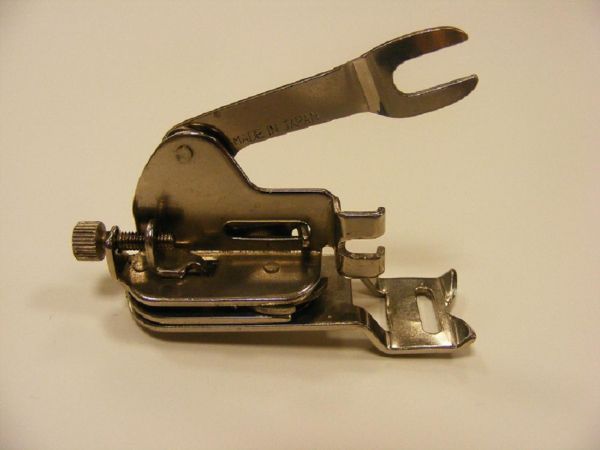
Readers helped solve the mystery of how this unusual sewing machine foot is used.
In September, I sought the assistance of Threads online readers to help figure out the purpose of an old sewing machine foot that I have never been able to use. The foot had been part of my mother’s collection of sewing notions that I inherited many years ago. As in most mysteries, a combination of input from many sources led me to the solution.
Many of you thought it was a ruffler. I didn’t agree, because I also have an old ruffler. Although they look very similar, when you hold them side-by-side, they are quite different.
Others believed it was a zig-zag foot for an early machine that didn’t have zig-zag capability. My mother’s machine could only make a straight stitch, so this was a good possibility. But when I tried to use it on my machine, the base of the foot didn’t go down far enough to meet the throat plate. (All of my mother’s old specialty feet fit perfectly on my machine.) It wasn’t until I read the comment from sewnso for about the third time that the light-bulb went on in my head. She said, “I thought I was one of few that had this heavy sewing machine foot…” Although she was incorrect about the use of the foot (she also thought it was a ruffler), her word “heavy” got me thinking. My mother made lots of coats over the years for herself and for my sister and I. I pondered the possibility that perhaps this foot was a specialty foot meant for heavy fabric. I took some heavy double sided fleece and gave it a try. To my surprise, it stitched a beautiful zig-zag stitch. It was interesting to watch, because the needle stitched a straight line, but, as many of you suggested, the foot actually moved the fabric from left to right as it stitched. The button screw at the back of the attachment controlled the width.
I’m thrilled to finally know what this foot is for, but even more importantly, it made me truly appreciate my sewing machine. My machine may not be the newest machine on the market (far from it), but at the touch of a finger, and without special attachments, I can create many different zig-zag and other stitches that my mother and grandmother could only have dreamed about. How fortunate we sewers are in today’s world. Not only do we have great machines available to us, but we also have incredible notions to make our sewing easier, quicker and better constructed. Are we lucky, or what??
Thanks to all of you who helped solve this mystery. Watch for another mystery attachment coming soon.


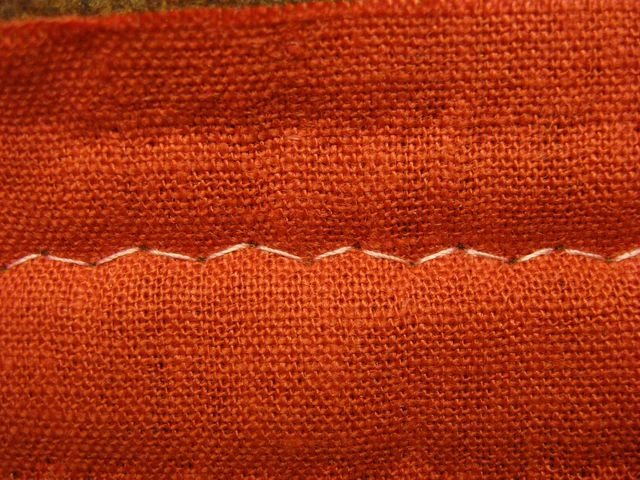
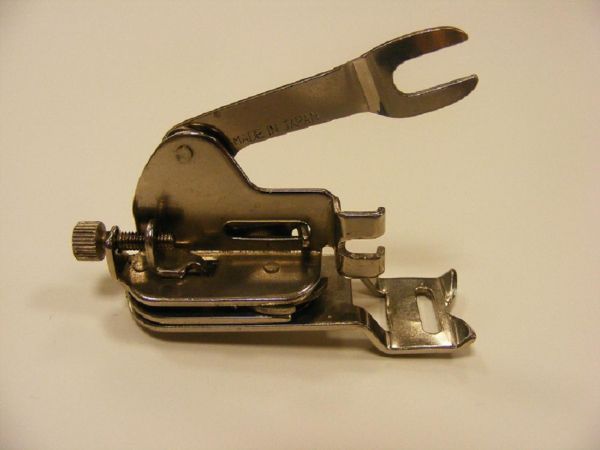
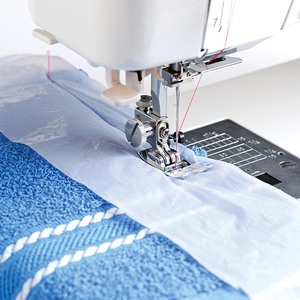
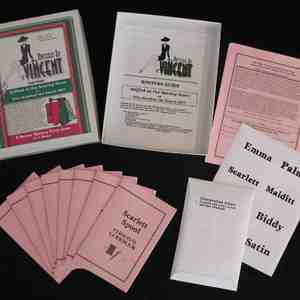




























I remember the presser foot blog! I knew it wasn't a ruffler foot, but I had NOOOO clue as to what it would be used for, so I kept my mouth shut! :X ...I find the results fascinating. Thanks for the update.
What a cool find! I loved the "name the presser foot" mystery and am glad to see we have an answer.
However, despite the "touch of a button" magic of modern machines you speak of, I don't use the vast majority of fancy features on my newer machine. And in fact, for the wool flannel pants I'm sewing on now, I'm using my only other sewing machine - a 1950 Singer Centennial 201-2 (a cast iron straight stitch machine) - including the buttonhole attachment, a large "monster" to be sure - but it makes the best buttonholes I've ever seen on a home machine!
So I say, sometimes older and "simpler" can be better! ;-)
Mystery Sewing Machine Foot
I'm pretty sure that this foot is missing a piece. My buttonholder has a plate that screws OVER the throat plate of the machine, so that it can swing the fabric back and forth freely. The feed dogs on the older machines didn't go down, so they had to be covered.
I think your mystery foot IS a regular zigzagger, as some of us suggested, but I do believe its missing a piece which would make it work on regular weight fabrics.
If you read my second post on the original question, you see this...
There probably should be a plate that goes under it that has a wide opening for the zigzag stitch, but which also covers the feed dogs.
In any case, if you are trying it on another machine, you should drop your feed dogs, as I'm pretty sure this foot will push the fabric from side to side as it works and you shouldn't hold onto the fabric while its working.
If you can find a throat plate for a buttonholer, it will probably work the same with this foot.
Emmy
It is a Walking Foot; used when you quilt or when you have a thick layer of fabric to sew on. I usemine with my Viking SE I sewing/embroidery machine.
I love when a good mystery comes together-lol! Looking forward to the next "mystery".
I have sorted my threads by color and have them stored in cutlery trays that stack by 2's in the drawers of a small cabinet. Easy to see the colors andtake to the machine if necessary. I also have another cutlery tray that holds all my necessary equipment and it is near the machine on top of the cabinet. The bobbins are stored in one of the sections.
so nice to found out that the foot is used for heavy fabric sewing, i have had this foot in my sewing box also but now i would like to know just how you use it and how the fabric looks going thru the sewing machine
thanks you for any help
dee
I too am happy to find out the real purpose for this foot. I must try mine out as I have never really used it. This was worth waiting for...
Shelly
I'm surprised that this was a mystery! My mother's Singer Touch and Sew machine had one of these (admittedly with some plastic areas) in the 1970s. It is called a walking foot. The large lever at the top fits around the screw that holds the needle in place. This lifts the foot away from the fabric after each stitch as the needle rises, allowing the feed dogs to move the fabric. As the needles comes down, the foot presses onto the fabric again so that it is held firmly as the needle penetrates the fabric.
It is not only for use on heavy fabrics, although it is wonderful for that. It is also useful for matching plaids and for stitching slippery fabrics as it stops the top piece of material from sliding over the bottom one.
I remember that my mum used it a lot and it was her solution to all difficult fabrics that used to make her curse...
Dear April,
I'm so curious what your sewingmachine looks like!!Could you please post it on the site?
In the eighties I bought a Pfaff 1229, but about ten years later I thougt I had to change this fabulous tool for a computer sewing machine. How sorry I soon was! I missed the simple turning and pressing of buttons, and I stopped sewing altogether. A few years ago I bought back a Pfaff 1229. It looked used, and not quite so well looked after like I'm sure my own machine would have looked like if I had kept it...
But I was happy to find the old Pfaff back -which is very rare- and I'm a happy sewer again.
Conclusion: DO NOT EVER SWAP YOUR OLD GOOD SEWING FRIEND FOR A DAZZLING LOOKING YOUNGER ONE!
I want one!!! Is there one to fit my Pfaff Grand Quilter (hobby 1200) to save me switching machines/threading etc just for a little zigzag in a project??
I loved this! By the way, I have an oak box, about the size of a pound of butter, that opens up (actually, it kind of unrolls and lies flat). It's full of strange-looking feet and other attachments. I don't know what any of them are, except that they seem to fit on my Featherweight. On top of that, a helpful greatnephew took them all out of the box, and now I have no idea how they go back in.
Does anyone out there know what I'm talking about? Some of the things are really odd-looking. I'd love to know more.
I'm so glad to see the solution to this mystery - I'm wondering whether that 'bulky' foot might also work for machine quilting?
Also, for heavy plaids - would it also be good to use for 'matching up'?
I've really enjoyed the comments on this post - wonderful contributions.
Hello - this is my first time posting, but I read the postings about the mystery foot. 'Robinbobbin' I too have one of those boxes you describe. I think it came with, or was purchased at the same time as an old treadle machine I bought in 1975/6. I don't think it actually went with the Singer machine, and I am not sure what the pieces are all for. Neat box though!
That's so awesome.
I also have a box of old attachments from my grandmother. Most of the feet I know what to do with, but this one stumped me. I do a lot of crafts and sewing for my grands and this will be something I can now use. Thanks.
So.... It's a zigzag foot for heavy fabric?? Or just a zigzag foot? I'm still not clear on what it is?
~Tracy
Yes, it's a zig-zag foot. It certainly doesn't have the variety of settings that the zig-zag stitches on today's machines have, but I suspect it was cutting-edge in its day. The needle stitches up and down without moving side to side, but the "knob" on the bottom of the foot grabs the fabric and pushes it first left and then right as the needle goes up and down, thereby causing the zip-zag to happen.
It didn't work with thin, cotton fabric because the "knob on the bottom of the foot wasn't able to grab the fabric and move the fabric back and forth. If you click on the link to my original blog (The link can be found in the first sentence above--"sewing machine foot"), you can see the knob in the photo of the underside of the foot (you can read the word "PATENT" near the knob).
When I used two layers of heavier fleece fabric, it worked just fine because the thickness of the fabric allowed the knob to grab the fabric to move it. I would never use this foot since my sewing machine does a zig-zag stitch much more easily, but it certainly was interesting to watch.
Oh wow....isn't it astounding how we, in this day and age, get all excited about new tools and gadgets when "mom" or "grandma" already had something that did the same job....fascinating..
Hello: I have enjoyed reading about your desire to learn what this big foot is and I have a modern version of that foot and I agree with one of your other readers that it is called a Walking Foot. It is used to ease thick fabric through the sewing process and is also used by quilters to feed the thick layers of quilt through evenly. I also have a ruffler foot and it does not look like that, it is definitely a "Walking Foot", they are expensive, a modern foot like that costs around $300.00. Happy sewing!!!